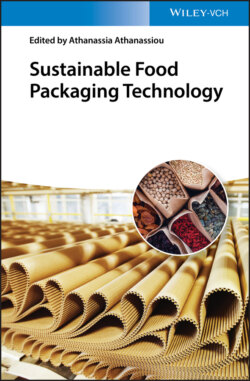Читать книгу Sustainable Food Packaging Technology - Группа авторов - Страница 41
2.3.3 Food Shelf Life Extension Using Chitosan Films and Coatings
ОглавлениеChitosan films and coatings have been extensively assessed for non‐processed food, such as fruits, vegetables, refrigerated fish, and meat as well as for processed food such as sausages or bread. Depending on the product, different coating techniques are used: dipping, spraying, or wrapping. Leceta et al. [122] compared spraying and dipping on ready‐to‐eat baby carrots and found that both chitosan coatings were effective in maintaining the product safe against microbiological spoilage during a storage period of 15 days. A slightly better antimicrobial activity was shown for dipped samples, whereas moderately better results for weight loss and texture were presented in sprayed samples. Pea pods have also been coated by chitosan solutions, reducing the vegetable weight loss, titratable acidity, and chilling injury compared to the untreated product [123].
In order to provide the packaging with active properties that prolong the shelf life of the packed product, additives are incorporated into chitosan solutions. Some of these studies are summarized in Table 2.2. Lekjing [130] employed clove oil, an essential oil with antimicrobial and antioxidant properties, to coat pork sausages by dipping and microbiological, physical, and chemical analyses as well as sensory evaluation were carried out. It was demonstrated that the coating inhibited the microbial growth, retarded the lipid oxidation, and extended the shelf life of the product during refrigerated storage. However, negative impacts were found on odor and taste qualities. Other essential oils, such as that extracted from oregano, have also been incorporated into chitosan solutions to provide coatings with active properties. Paparella et al. [131] added oregano essential oil into chitosan solutions to coat fresh pork fillets and found that oregano had antimicrobial properties against meat spoilage bacteria, such as Brochothrix thermosphacta and Pseudomonas spp. In another study, Alsaggaf et al. [127] analyzed the effect of edible chitosan coatings applied by immersion of Nile tilapia fillets into chitosan solutions with pomegranate peel extract, an extract that has several bioactive phytochemicals for antimicrobial or food preservative applications. Composition, microbiological, antioxidant, total nitrogen volatile base value, and sensory analyses demonstrated that chitosan/pomegranate peel extract coatings were effective at extending the shelf life of fish fillets.
Table 2.2 Chitosan‐based active films and coatings.
| Food packaged | Packaging | Bioactives | Bioactivity | References |
|---|---|---|---|---|
| Cherry tomatoes and grapes | F | Tannic acid | AO + AM | [124] |
| White shrimp (Litopenaeus vannamei) | C | ɛ‐Polylysine | AM | [125] |
| Bread slices | F | Apricot kernel essential oil | AO + AM | [113] |
| Chicken | F | Schinus terebinthifolius Raddi (pink pepper) extract/peanut skin extract | AO | [126] |
| Nile tilapia fillets | C | Peels of pomegranate extracts | AM | [127] |
| Grass carp (Ctenopharyngodon idellus) | C | Glycerol monolaurate | AM | [128] |
| Yellow croakers | C | Nisin | AM | [129] |
| Pork sausages | C | Clove oil | AO + AM | [130] |
| Tomatoes | C | Iodide | AM | [116] |
| Pork fillets | C | Origanum vulgare essential oil | AM | [131] |
| Pacific mackerel (Pneumatophorus japonicus) fillets | C | Gallic acid | AO + AM | [132] |
| Chicken breast | C | Zataria multiflora essential oil/pomegranate juice | AO + AM | [133] |
C, coating; F, film; AO, antioxidant; AM, antimicrobial.
In addition to coatings, chitosan films have been used to wrap food products with the aim of prolonging food shelf life. Serrano‐León et al. [126] wrapped chicken products using chitosan films incorporated with peanut peel extract or pink pepper by‐products. Peanut peel extract contains proanthocyanidins and procyanidins, phenolic compounds with antioxidant activity, while pink pepper by‐products are composed of vitamin C, phenolic compounds, flavonoids, and carotenoids. The characterization of the chicken product was carried out analyzing chicken pH and color, peroxide value, thiobarbituric acid reacting substances (TBARS), and microbiological parameters. None of the additives altered chicken pH or color, but pink pepper by‐products showed greater antimicrobial and antioxidant activities than peanut peel extract.
